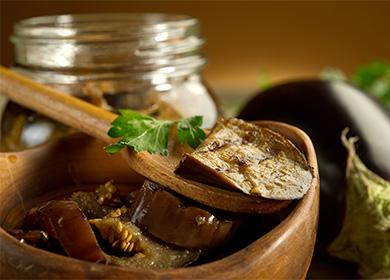Multiple recipes for pickled eggplant for the winter indicate that this dish is loved in our country and is enjoyed with food. The optimal time for harvesting blue ones is considered to be the period from the end of August to the end of October. It is advisable to select fruits of solanaceous fruit of the same size. On the surface of vegetables should not be damaged or scuffed. Ponytails must be green and fresh. The dried “tail” is evidence that the vegetable has been stored away from the bush for a long time. So, you should not use it for winter harvesting.
Counting calories
Eggplant is one of the five lowest-calorie vegetables. 100 g of this product is 24 kcal, so it takes an honorable fifth place in the list. Ahead of him are green bell peppers, spinach and ground cucumbers with tomatoes. The table provides a detailed calculation of the nutritional value of blue fermented under oppression, prepared according to the classic recipe.
Table - Nutrition value of “classic” pickled eggplant
| Product | Mass g | Calories, kcal |
|---|---|---|
| Onion | 110 | 45 |
| Carrot | 140 | 44 |
| Little blue | 1000 | 240 |
| Vegetable oil | 30 | 270 |
| Garlic | 20 | 28 |
| Salt | 3 | 0 |
| Celery | 30 | 3,6 |
Soaked, pickled, salted: what is the difference
“Soaked eggplant for the winter” - this phrase can be heard and read quite often. But it does not sound entirely correct. The fact is that there are no soaked eggplants. Mistresses often confuse such methods of harvesting vegetables and fruits as pickling and urinating. In fact, the meaning of these processes is one and the same: to preserve the fruits collected in the summer cottage with the help of lactic acid, which is formed due to sugar fermentation. But what is the difference? The table will tell.
Table - Categories of fruits that are fermented, soaked and salted
| Conservation Method | Products |
|---|---|
| Urination | - plums; - pears; - apples; - berries |
| Souring | - Cabbage; - eggplant |
| Salting | - Cucumbers; - tomatoes |
The subtleties of the process
In order for fermented eggplants, prepared for the winter in jars, to work out well, it is necessary that in the container where they are placed, lactic acid is formed in the right amount. This substance appears in the process of sugar fermentation, which is affected by lactic acid bacteria. It turns out that sugar is the most important component of any recipe for urinating, pickling or pickling. And auxiliary - salt.
- Sugar. It is found in any fruit - whether it is a fruit or a vegetable. A sufficient amount of it is the key to success. Sometimes it is necessary to add granulated sugar separately, but if there is enough sugar in the product, the recipe can be eliminated from a harmful additive. After the conversion of sugar into acid, this substance begins to create obstacles insurmountable for other microorganisms. The latter stop their reproduction, thereby preserving the fruits.
- Salt. It is necessary not only to salt the dish, making its taste more pronounced and vibrant. Salt extracts egg juice from eggplant, which contains sugar necessary for fermentation. True, you need to salt only slightly. Peresol will lead to a deterioration in the taste of the dish and inhibition of the work of lactic acid microorganisms.
3 conditions
In order for you to successfully preserve your favorite vegetable, follow certain rules, the main of which is a sufficient amount of sugar in the main ingredient of the prepared dish. For example, sugar is always added additionally to cucumbers. But most varieties of eggplant do not need it. Therefore, do not be surprised if you do not find sugar in recipes. Compliance with the following three conditions will also be the key to a successful conservation.
- Minimum oxygen. In order to keep eggplant to the maximum vitamin C, which they are rich in, you need to minimize the amount of oxygen. You can do this by putting vegetables in a pot or bucket, covering with a lid or plate with a diameter smaller than that of the container, and putting oppression on top. It is easy to do such a trick with cabbage - oppression easily condenses the shredded vegetable. But whole eggplants are not always able to be qualitatively compacted. Especially if the fruits are large. So watch out for the brine. In the classic recipe, it should completely cover the blue ones. If the liquid level drops, add an additional 3% saline solution to the container.
- Temperature mode. Fermentation takes place actively at temperatures from 15 to 22 ºС. You can speed up the release of enzymes by raising the temperature in the room where the eggplant is boiling. But the finished product needs to be stored where the air temperature is close to 0 ºС and does not rise above 5 ºС.
- Sanitary requirements. The most elementary of all conditions is compliance with the sanitary regime. It consists in the cleanliness and freshness of the products used to prepare the workpiece. And also in the absolute cleanliness of the dishes involved in the process.
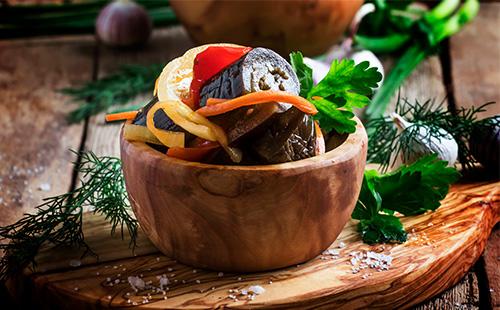
Pickled eggplant for the winter: traditional and oriental
Blue fermented eggs are usually not cooked without filling, with the exception of the classic, time-tested recipe. Stuffed vegetables are usually neighbors in the garden - carrots, garlic and lots of herbs. Some recipes use finely chopped cabbage instead. It turns out no less tasty and unusual. Getting to the study of recipes, note: each of them indicates the net weight of the main ingredient. That is, the mass of eggplant without cleaning. Depending on the recipe, the cooking time may vary. For example, an Armenian snack can be served at the table one day after pickling. But the Georgian version must be kept in brine for about a week.
Classic
Feature. The highlight of this dish is the clean eggplant flavor. Due to the fact that no auxiliary vegetable ingredients are used in it, eggplants are obtained as natural as possible - without impurities of other people's aromas. When eating such blue ones in food, they can be pre-stuffed with a filling of fresh vegetables. Or you can just cut it into rings and eat it with boiled potatoes or fried meat. A taste of garlic for a change will be quite enough.
Product Set:
- eggplant - 2 kg;
- garlic - two large heads;
- Bay leaf;
- salt.
Conservative Actions
- We prepare a brine: we take one part of salt into four parts of water.
- We boil the brine and boil in it peeled vegetables for 5 minutes.
- We spread the boiled blue ones in a colander so that excess water from them is glass.
- We make a “pocket” on each eggplant and fill it with a mixture of ground black pepper and chopped garlic.
- We prepare the marinade at the rate of 30 g of table salt per 1 liter of water. There we send "lavrushka" and allspice. Boil and wait until it cools.
- Pour vegetables, tightly packed in a pan, with a cooled marinade.
- Store fermented eggplant cooked in a cold way, it is necessary in the cellar or refrigerator for a week.
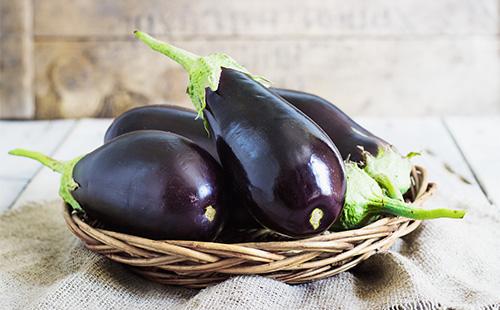
No brine
Feature. Sour eggplant stuffed with carrots and garlic is harvested without brine and without sterilization. They also involve the preliminary preparation of the main ingredient. After washing and removing the stalks, the vegetables are cut with a knife along, cutting each blue one about ¾ in depth and leaving 2 cm on each side to get a kind of “pocket” for the filling. After the nightshade is put in a wide stewpan or pan, poured to the top with pre-prepared saline and boiled for ¾ hours.
Product Set:
- blue ones - 2.3 kg;
- carrot - 0.5 kg;
- parsley root - 0.1 kg;
- onions - 0.1 kg;
- garlic - two middle heads;
- salt - for saline solution and filling;
- parsley - a bunch;
- vegetable oil - a glass.
Conservative Actions
- We take out the boiled little blue ones and place them under oppression to remove excess moisture.
- Preparing the filling: pass the finely chopped onions, and chop the carrots and parsley root with thin sticks. Pass the garlic through a press and mix with the rest of the ingredients.
- Fry carrots and parsley root in a pan for ten minutes, and then add garlic to them and pour finely chopped greens. Stew for another three to four minutes and mix with passivated onions.
- Salt the filling and stuff the eggplant fruit with it.
- We dress each stuffed with a blue thread so that the stuffing does not fall out, we put the nightshade fruits in a wide container, put oppression on top, and instead of the lid use gauze.
- On the third day we shift the blue ones into glass jars, fill them with calcined sunflower oil, cooled to 70 ° C so that it completely covers the fruits, and remove the container in a cool place, after having covered it with a nylon cover.
Azerbaijani
Feature. Azerbaijani eggplants can be cooked strictly according to the recipe, or they can be laid in layers without starting blue ones. Both methods are considered authentic. The amount of vitamin C due to the participation of a fair amount of greenery increases several times. The greens are practically not subjected to heat treatment. So, a snack prepared for the winter will become a real vitamin bomb. In addition, fresh seasonings can be selected to taste, replacing ordinary basil with lemon, and adding cilantro instead of dill.
Product Set:
- blue ones - ten small ones;
- celery root - one small;
- paprika - one;
- chili - pod;
- carrots - four small;
- parsley - two bunches;
- mint - half a bunch;
- dill - a bunch;
- basil - half a bunch;
- salt and black pepper - to regulate the taste;
- cloves;
- Bay leaf;
- allspice peas.
Conservative Actions
- We washed and peeled solanaceous fruits to make a pocket in each vegetable, and send them to the pot with boiling water for 5 minutes.
- We take out the eggplants, chill and with the help of a knife or a dessert spoon we clean the seeds from the fruits.
- We wash the whole set of greens well under running water, leave until completely dry, and then finely chop.
- Peel and grind carrots on the finest grater. Pass the garlic through a press, and cut the pepper with the removed seeds and partitions into small pieces.
- We clean the celery root, eliminate hard veins from it and grind it on a fine grater.
- We mix all the ingredients of the filling in a common bowl, season with salt and pepper to taste, stuff the eggplants.
- We prepare the marinade: boil water, add spices, boil them in boiling water for five minutes and turn off the stove.
- After the marinade has completely cooled to room temperature, we fill it with the stuffed blue ones pre-packed in a bucket or pan, put oppression on top and send it to a cool place for six days.
- After six days, we take out the vegetables, put them in jars and put in the refrigerator. If desired, we can preserve it, having previously sterilized a container filled with a snack.
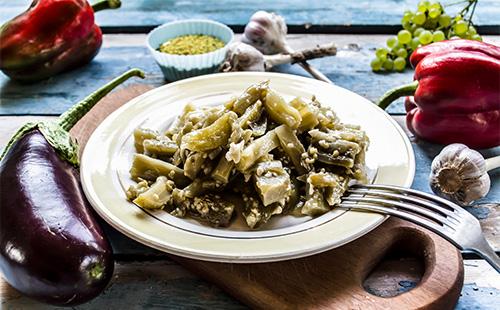
In Georgian
Feature. Georgian eggplant, pickled with carrots, herbs and garlic, is the most spicy of the proposed dishes. Of course, it can be prepared without red pepper, minimizing its presence in the snack or, in general, eliminating. But Georgians are sure that the “hobbyhorse” of these salted eggplants is precisely in sharpness. Residents of Georgia believe that their eggplant is the best cure for a hangover. Especially if they bite chacha in the morning after a stormy holiday.
Product Set:
- blue ones - 1.8 kg;
- carrot - 350 g;
- garlic - five cloves;
- ground red pepper - a quarter of a tablespoon;
- cilantro - a bunch;
- celery - a bunch;
- dill - half a bunch;
- water - 2 l;
- salt - three tablespoons with a slide;
- 9% vinegar - a tablespoon;
- sugar - a tablespoon.
Conservative Actions
- We clean, wash and make "pockets" in eggplant. After boiling them in boiling water for five minutes.
- We take out the little blue ones, put them in a wide colander, cover with a plate on top and set a pot of water on them as oppression, where they were cooked.
- We rub the carrots on a special grater intended for Korean salads, mix with chopped herbs and garlic passed through a press, mix and adjust the taste of the filling with salt and pepper.
- We stuff the eggplants and tightly put pot-bellied vegetables in a wide pan.
- We boil water, add vinegar, salt and sugar into it, pour hot marinade, set oppression again and send it to the refrigerator for a week.
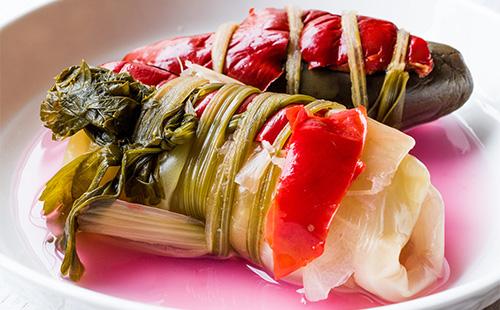
In Armenian
Feature. Armenian eggplants are stuffed with a mixture of bell peppers. It is better to take paprika in different colors. So the dish will turn out more fun and brighter. Another feature of the recipe is that the little blue ones are used without cooking - they are pre-baked on an open fire. However, on the Internet you can find many Armenian recipes that declare preliminary boiling. But then the haze will no longer have the aroma of aroma. A dish is cooked per day, therefore, it belongs to the category of instant preparations.
Product Set:
- eggplant - 2.5 kg;
- bell pepper - four large;
- chili - pod;
- parsley - two bunches;
- dill - a bunch;
- garlic - head;
- apple cider vinegar and salt - for the marinade.
Conservative Actions
- We clean the eggplant from the stalk, pierce each vegetable in several places with a toothpick, and, planting it on a skewer, send it to the barbecue. We cut the "pockets" after baking.
- Finely chop all the greens, compress the garlic, chop the bell peppers in as small cubes as possible.
- We mix the ingredients of the filling and stuff them with baked and cooled blue ones.
- We put them in a pan, pour apple cider vinegar to the top and pour two tablespoons of table salt.
- We put containers with blue ones in the refrigerator, and after 24 hours we serve or roll them into jars.
Knowing how to ferment eggplant is only half the battle. It is equally important to know how to store them correctly if they are not preserved.The storage location may be a refrigerator or a cellar. The latter option is most comfortable if the volume of the workpiece is large. For example, a barrel or a large pan. The maximum temperature limit for pickled eggplant is 6 ° C. The dish is not picky, tolerates frost well, so you can safely keep it on a glazed balcony. They say that fermented and filled blue can even be frozen. But when defrosting, keep it exclusively in the refrigerator - so as not to spoil the taste of savory foods.
Reviews: “The most important thing is not to digest”
At the height of the season, I boil eggplant in salted water until tender, then for 6 hours under the press, then lay them out for 5-6 pcs. in plastic. containers and in the freezer. And you can indulge all winter with pickled eggplant without bothering about their storage. Defrost and stuff before cooking. The most important thing is not to digest the eggplant. And yet, after the blue stuffed them, put them tightly in a saucepan and put on top something heavy (a saucepan with water or a brick). I have a very warm house and it takes 3 days to cook.
D @ niella, http://forumodua.com/showthread.php?t=57712
It is necessary that the eggplants are completely covered with calcined oil, then they can be stored until spring, summer, but naturally in a cool place, such as in a refrigerator or in winter on a loggia, balcony. In oil, they will never mold. I do this every year. The same story with tomato paste: pour a little oil on top and will not mold for a very long time.
Damo4ka, http://forumodua.com/showthread.php?t=57712
Did you know that in Moscow the process of fermentation is going very differently, not like in Odessa, for example. Firstly, very slowly. Of course, the climate here is completely different, and the eggplants are different, they come to us for a long time, like other vegetables and herbs. I fermented cucumbers in jars, the readiness indicator is a mold film on the surface. Then the brine is drained, boiled and the jars are corked for long-term storage. My grandmother in Odessa showed mold after three days, and did not appear in Moscow in a week. On the tenth day, she stopped the process by force)) Remember how Zhvanetsky has? “Repair cannot be completed, it can only be stopped ...” The reason is most likely due to differences in climate and general microbiological background. There are many examples of such features in the world, this is a specific mold on cheeses, which alone can form only somewhere in Italy, but not in Gomel, or the famous San Francisco bread, on a local specific-acidic sourdough. Ferment in San Francisco becomes such a thing by itself, and in other cities it loses its specificity.
annato https://moyugolok.livejournal.com/566714.html
Fermented eggplant is the most delicious on the fourth day, then they should be stored in the refrigerator, always under pressure, so that the liquid completely covers them. The vessel, of course, is covered with a lid. Eggplants are stored in the refrigerator for about two weeks, maybe longer, but they become very pickled)))
Alyona, http://www.good-menu.com/ensalada/baklazhany-kvasheniye9.html
Azerbaijani grandmother always made such eggplants. We loved fried, boiled potatoes ... I do, but according to the recipe from a set of postcards from the 60s, “Azerbaijan Pickles”. Also very tasty.
Vera Rakhimova, http://russianfood.com/recipes/recipe.php?rid=119196
Other homemade recipes
Zucchini like pineapples for the winter
Eggplant in adjika for the winter
Eggplant like mushrooms for the winter
Dandelion jam
